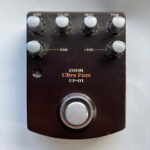While you might assume your PlayStation 2 (PS2) controller would seamlessly work with Guitar Hero 2 (GH2), you’ll quickly find that’s not the case. Interestingly, this compatibility issue is specific to GH2; the original Guitar Hero (GH1) doesn’t have this limitation. So, if you’re aiming to build a custom Guitar Hero controller, especially for GH2 and later versions up to Rocks the 80s, understanding this controller nuance is crucial.
Why a PS1 Controller for Guitar Hero 2?
The reason GH2 is particular about controller types boils down to its input requirements. Unlike GH1, Guitar Hero 2 demands a digital controller equipped with analog sticks. Now, you might be thinking, “But the PS2 controller is analog!” And you’d be right – PS2 controllers are indeed analog, even boasting pressure-sensitive buttons. Despite this, for reasons not entirely clear, GH2 simply doesn’t recognize the standard PS2 controller for guitar input.
This peculiarity leaves us with one definitive solution for ensuring compatibility with Guitar Hero 2 and subsequent compatible titles: the original PlayStation 1 (PS1) controller. If your goal is to create a Guitar Hero controller that works flawlessly with GH2, a PS1 pad is your essential starting point.
Wiring Your PS1 Controller for Guitar Hero 2
Let’s dive into the wiring specifics to transform your PS1 controller into a functional Guitar Hero input device. Below is a breakdown of the connection points you’ll need to solder. This guide assumes you are comfortable with basic soldering and electronics work.
-
Left D-pad (Always Pressed Down): Solder the connection as if the left d-pad button is constantly pressed. This signals to the PS2 system that a guitar controller is connected. In-game, pressing left on the d-pad will typically open the tutorial menu, confirming correct setup.
-
GND (Ground): This is your ground connection, necessary for all switches in your setup. Fortunately, PS1 controller boards usually offer multiple ground outlets for convenience.
-
Up D-pad: Connect this to your “strum up” switch.
-
L2 Button: Utilize the L2 button connections (usually two outlets available) for your motion sensor input, which activates “star power” in Guitar Hero.
-
Down D-pad: Connect this to your “strum down” switch.
-
Select Button: While its uses are limited, the select button can also be wired to activate “star power.”
-
Start Button: Essential for pausing the game and accessing the in-game menu.
-
Square Button: This will function as your orange fret button. Note that some PS1 controller PCBs may lack an extra solder pad for this button, so exercise caution when soldering.
-
R2 Button: Connect this to your green fret button.
-
Cross Button (X): This becomes your blue fret button.
-
Circle Button: Your red fret button.
-
Triangle Button: This will be your yellow fret button.
-
Y-axis of the Left Analog Stick: Use the Y-axis of the left analog stick for your whammy bar trimmer. Connect it between the GND and Ucc (see below).
-
Ucc (Voltage Common Collector): This is a voltage source. The easiest point to find a Ucc connection on the board.
Important Note: When wiring the whammy bar to the Y-axis, you’ll be creating a trimmer potentiometer setup. The whammy bar will vary resistance between GND and Ucc, and the controller board will interpret this change in resistance as whammy bar input.
Optional Tip for Modders: It’s generally recommended to remove the rumble motors from the PS1 controller. Rumble functionality isn’t utilized in Guitar Hero and removing them can simplify your controller modification and potentially reduce weight.
Conclusion
While the Ps2 Guitar Hero Controller might seem like the obvious choice, for Guitar Hero 2 and similar games, the reliable PS1 controller pad is the key to a successful DIY guitar project. By understanding the controller compatibility nuances and following this wiring guide, you’ll be well on your way to rocking out with your custom-built Guitar Hero controller. Remember to double-check your connections and enjoy the process of bringing your guitar creation to life!

